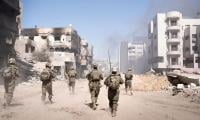This piece is inspired by two wonderful articles published last week in this and another newspaper. Kamal Siddiqi and Mosharraf Zaidi, two writers of eminence, brought the focus back on the much-talked about but little explored topic of the youth bulge.
Reading these articles was an intellectual treat. What distinguished these pieces from others was their intelligent and detailed treatment of a segment of our population – Generation Z – that has been described as being central to any effort for national rejuvenation.
The youth bulge, with roughly 55 percent of the population being less than 29 years of age, is Pakistan’s window of opportunity to catapult itself into the league of developed nations. The amazing prospects for fast-paced growth are followed by the dire threats of upheavals caused by our national failure to leverage the robust but raw energies of our youth. As a result, the dynamics unleashed by this important segment of our demography are deep in nature and far-reaching in their impact. They have the potential to reshape our state and society.
It is, therefore, essential that our national conversation focuses on the youth, the varied challenges they face and how these challenges can be converted into opportunities through meaningful state intervention. There is enough evidence from across the world that suggests the rising level of expectations of the teeming millions, especially those of the youth. These expectations are not just centred on obtaining a greater share in the economic cake that is commensurate with their burgeoning size, but also focus on demanding a greater say in deciding national affairs.
In discussing the characteristics unique to a generation born after 1995, better known as Generation Z, the writers identified the role of technology that has shaped many of this generation’s reference points and the nature of their interactions with the state and society. Since our access to the world and all that is happening in it is just a click away, thanks to the growth of ICTs and their penetrating role in our lives, the contribution of the technological factor in shaping the worldview of Generation Z is well-documented.
However, to presume that technology always plays the role of an equaliser is to overlook the digital divide that is a fact of life and which distinguishes the urban areas from the backward ones. Both articles seem to be directed at the urban youth to the exclusion of young people who live in the rural hinterlands. For this segment of the youth, life offers different experiences and insights. Therefore, an assessment of their predicaments, challenges and opportunities is required to arrive at a balanced conclusion regarding the potential of Generation Z to effect meaningful changes.
The lives of the rural youth have been shaped by an array of factors and institutions that have a bearing on their way of thinking and subsequent actions. Ever since they gained consciousness in the years after 2000, this version of Generation Z has seen the world in perpetual turmoil. The political conflicts, unending wars, suicide bombings and terrorism have filled their minds with images that have lowered the bar for the use of violence as a means of getting their demands accepted. The blowback effect on the country, which has found itself involved in the war on terror as a frontline ally, has deepened the influence of violence.
Pakistan has witnessed a massive media revolution around the same time that this generation was at school. Political analysts, news anchors and the content aired on TV talk shows have helped them form first-hand impressions of the world around them. Debates on a range of issues have served as their primary source of information and opinion-making, irrespective of the questions being raised about the authenticity of the information and data that is pedalled round the clock by TV channels.
While the media’s role in strengthening the culture of free speech and keeping a check on the government is laudable, the content aired on TV channels leaves a lot to be desired in terms of its efficacy, correctness and compliance with the requisite journalistic standards. Operating in the absence of strict code of conduct, the Pakistani media has unfortunately promoted bigotry and partisanship in the present socio-political milieu. No-holds-barred sabre-rattling on TV screens, which is solely meant to boost ratings, has deeply impacted an entire generation, turning them into warriors who gain more motivation from emotions than through logic as they grapple with the issues that surround them.
The kind of education offered at the educational institutions that the youth of semi-urban and rural areas attend has the ultimate objective of providing them with degrees rather than the intellectual wherewithal to resolve the complex problems of human existence. The problem becomes acutely complex when you consider the vast number of young people who study at religious seminaries and are completely divorced from the demands of contemporary life. The various streams of education that have remained in vogue in Pakistan have built walls among different sections of society, thereby strengthening the divide on the basis of class and economic groupings.
Another problem that is closely aligned with the failure of our educational institutions is that learning outcomes are not commensurate with the demands of the market. As a result, we are swelling the ranks of the unemployed youth who have degrees but lack the requisite skill set to be able to be absorbed into the job market.
Political parties also have the potential to help bridge the divide and empower the youth. They can address the youth’s aspirations by clearly articulating their problems and suggesting concrete policies to resolve them. Unfortunately, this has not happened in the way it should have. There is a massive failure on the part of our political parties to meaningfully engaging with the youth.
It is indeed perplexing how such a critical segment that holds the key in terms of its sheer numbers and ability to spearhead the journey of national development has been unable to find the policy focus that it so richly deserved. Political parties across the world are nurseries that train the youth and mould them into a new generation of leaders who can lead nations in the future.
The consciousness of our Generation Z has evolved in an environment where the state has been confronted with the challenge posed by non-state actors of various hues who have sought to attack the symbols of the state. Although Pakistan’s story of combating terrorism and the violent non-state actors is indeed inspirational and unheard of, the fact remains that the challenges to the writ of the state have grown and need to be addressed through innovative and quick responses. If we align this with the unequal nature of our society, we are left with a deadly mix where radical forces can exploit the situation to target the vulnerable youth. The danger of radicalism, therefore, becomes quite real in such a socio-cultural and political milieu.
Responding to the challenge of the youth bulge in a holistic and comprehensive manner deserves utmost importance as well as urgency. We can learn a lesson or two from countries that have successfully turned this bulge into a demographic dividend. Political parties can play an important role in earnestly debating the matter.
The coming election season presents a golden opportunity for political parties to make up for lost time by manifestly articulating youth policies within their manifestoes. Generation Z is energetic and clear-headed, while also being restless and excited. It is time we harnessed their potential before their energies are squandered to our collective chagrin.
Email: amanatchpk@gmail.com
A representational image showing residents walking at a wholesale market in Karachi. — AFP/FileOnce again there is...
A representational image showing late Pakistani human rights activist and Supreme Court lawyer Asma Jahangir. —...
A representational image showing a security personnel sanding guard beside a ship carrying containers at Gwadar port....
A health worker administers polio vaccine drops to a child during a door-to-door polio vaccination campaign in Lahore,...
Armed militants of the banned Tehreek-e-Taliban Pakistan pose for a photograph in Orakzai Agency. —...
An aeroplane of the national flag carrier of Pakistan is seen in this file photo. — AFPWhile Pakistan considers...







